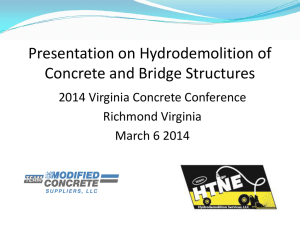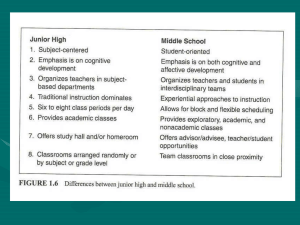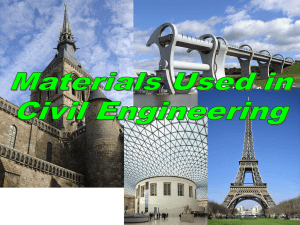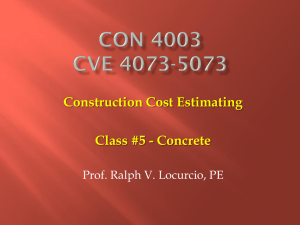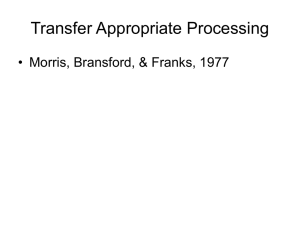Concrete Presentation
advertisement
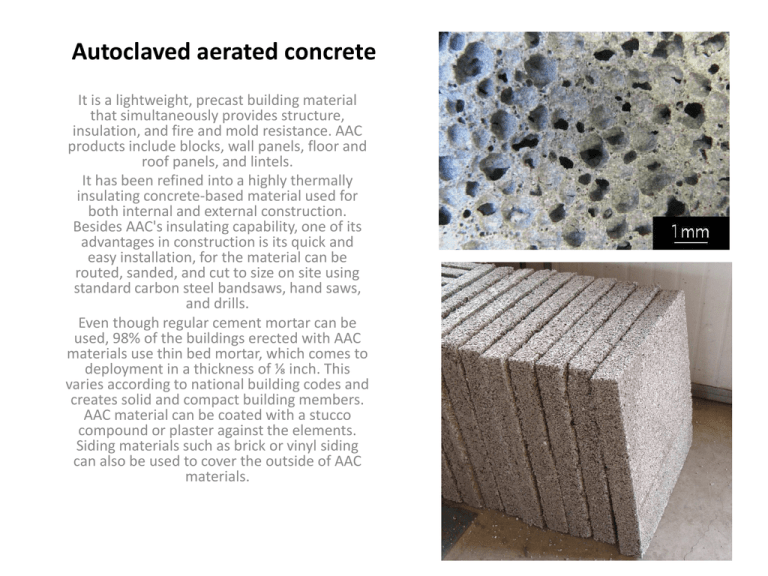
Autoclaved aerated concrete It is a lightweight, precast building material that simultaneously provides structure, insulation, and fire and mold resistance. AAC products include blocks, wall panels, floor and roof panels, and lintels. It has been refined into a highly thermally insulating concrete-based material used for both internal and external construction. Besides AAC's insulating capability, one of its advantages in construction is its quick and easy installation, for the material can be routed, sanded, and cut to size on site using standard carbon steel bandsaws, hand saws, and drills. Even though regular cement mortar can be used, 98% of the buildings erected with AAC materials use thin bed mortar, which comes to deployment in a thickness of ⅛ inch. This varies according to national building codes and creates solid and compact building members. AAC material can be coated with a stucco compound or plaster against the elements. Siding materials such as brick or vinyl siding can also be used to cover the outside of AAC materials. Asphalt Concrete Asphalt concrete is a composite material commonly used in construction projects such as road surfaces, airports and parking lots. It consists of asphalt (used as a binder) and mineral aggregate mixed together, then laid down in layers and compacted. It is also increasingly used as the core for embankment dams. http://pavementinteractive.org/index.php?title=Component_Analysis_-_Asphalt_Institute http://www.shutterstock.com/pic-50597974/stock-photo-gravel-gray-stone-textures-asphalt-mix-concrete-in-road-construction.html http://www.meredithbrothersinc.com/glasgrid.htm Autoclaved aerated concrete Biorock, also known as Seacrete, is a substance formed by electro-accumulation of minerals dissolved in seawater. The building process, popularly called accretion, is not to be confused with Biorock sewage treatment. The biorock building process grows cementlike engineering structures and marine ecosystems, often for mariculture of corals, oysters, clams, lobsters and fish in salt water. It works by passing a small electrical current through electrodes in the water. The structure grows more or less without limit as long as current flows. http://www.youtube.com/watch?v=0XuD10qzg9k&lr=1&user=thebiorockchannel Ferrocement The term ferrocement is most commonly applied to a mixture of Portland cement and sand reinforced with layers of woven or expanded steel mesh and closely spaced small-diameter steel rods rebar. It can be used to form relatively thin, compound curved sheets to make hulls for boats, shell roofs, water tanks, etc http://www.ruralize.com/Genes%20Projects/ferrocement/ferrocement%20garden%20bed.html http://www.anupamakundoo.com/www/node/37 Ferrocement Bench http://www.eugenesargent.com/bench1.htm Fiber-Reinforced Concrete Fiber-reinforced concrete (FRC) is concrete containing fibrous material which increases its structural integrity. It contains short discrete fibers that are uniformly distributed and randomly oriented. Fibers include steel fibers, glass fibers, synthetic fibers and natural fibers. Within these different fibers that character of fiber-reinforced concrete changes with varying concretes, fiber materials, geometries, distribution, orientation and densities. http://www.tecservices.com/Testing/FiberReinforcedConcrete/tabid/68/Default.aspx http://www.structuremag.org/article.aspx?articleID=340 http://www.structuremag.org/article.aspx?articleID=340 Lunacrete Lunarcrete, also known as "Mooncrete", an idea first proposed by Larry A. Beyer of the University of Pittsburgh in 1985, is a hypothetical aggregate building material, similar to concrete, formed from lunar regolith, that would cut the construction costs of building on the Moon http://eb-misfit.blogspot.com/ http://blogs.airspacemag.com/moon/2010/10/strange-lunar-brew/ Terrazzo Terrazzo is a composite material poured in place or precast, which is used for floor and wall treatments. It consists of marble, quartz, granite, glass or other suitable chips, sprinkled or unsprinkled, and poured with a binder that is cementitious, chemical or a combination of both. Terrazzo is cured, ground and polished to a smooth surface or otherwise finished to produce a uniformly textured surface. http://aggregateart.com/products-process/colors-are-our-specialty/ http://www.kafko.com/main.php?mod=vinyllistCDNC http://kitchendinner.com/Flooring/dune-megalos-stone-pizarra-nero-til.htm LiTraCon LiTraCon is a trademark for a translucent concrete building material. The name is short for "light-transmitting concrete". The technical data sheet from the manufacturer says the material is made of 96% concrete and 4% by weight of optical fibers, it was developed in 2001 by Hungarian architect Áron Losonczi working with scientists at the Technical University of Budapest. http://www.litracon.hu/downloads.php Pykrete Pykrete is a composite material made of approximately 14 percent sawdust or some other form of wood pulp (such as paper) and 86 percent ice by weight. Its use was proposed during World War II by Geoffrey Pyke to the British Royal Navy as a candidate material for making a huge, unsinkable aircraft carrier. Pykrete has some interesting properties, notably its relatively slow melting rate (because of low thermal conductivity), and its vastly improved strength and toughness over unmodified (crystalline) ice; it is closer in form to concrete. Pykrete is slightly more difficult to form than concrete, as it expands during the freezing process. However, it can be repaired and maintained using seawater. The mixture can be moulded into any shape and frozen, and it will be extremely tough and durable, as long as it is kept at or below freezing. http://simegen.com/writers/lois/pykrete.htm Silica Fume Silica fume is added to Portland cement concrete to improve its properties, in particular its compressive strength, bond strength, and abrasion resistance. These improvements stem from both the mechanical improvements resulting from addition of a very fine powder to the cement paste mix as well as from the pozzolanic reactions between the silica fume and free calcium hydroxide in the paste. Addition of silica fume also reduces the permeability of concrete to chloride ions, which protects the reinforcing steel of concrete from corrosion, especially in chloride-rich environments such as coastal regions and those of humid continental roadways and runways (because of the use of deicing salts) and saltwater bridges. http://en.wikipedia.org/wiki/Concrete#Chemical_admixtures http://www.tradekey.com/index.html?action=signup_step1&referrer=1 http://eurserveur.insa-lyon.fr/approphys/6applications/Nanotubes/Ap/Chemistry.htm Seeded Aggregate Finish Seeded Aggregate Finish: Small decorative stones are imbedded into the top layer of concrete, and during the finishing process, exposed to give a pebble texture to the concrete finish. This is a similar technique to exposed concrete, but instead of exposing the natural concrete aggregate, decorative aggregate is added when installed. http://en.wikipedia.org/wiki/Concrete#Chemical_admixtures http://www.tradekey.com/index.html?action=signup_step1&referrer=1 http://eurserveur.insa-lyon.fr/approphys/6applications/Nanotubes/Ap/Chemistry.htm Photocatalysts Photocatalysts, Self-Cleaning Concrete: When used on or in a concrete structure, photocatalysts decompose organic materials that foul the surface. The organic compounds affected by photocatalysts include dirt (soot, grime, oil and particulates) biological organisms (mold, algae, bacteria and allergens), air-borne pollutants (VOCs including formaldehyde and benzene; tobacco smoke; and the nitrous oxides (NOx) and sulfuric oxides (SOx) that are significant factors in smog), and even the chemicals that cause odors. The catalyzed compounds break down into oxygen, carbon dioxide, water, sulfate, nitrate and other molecules that are either beneficial to or at have a relatively benign impact on the environment. Most inorganic pollutants and stains, including rust, are not catalyzed. http://images.businessweek.com/ss/07/11/1113_concrete/source/7.htm http://www.concretedecor.net/All_Access/504/CD504_New_Tech.cfm http://www.axisdesignlab.com/photocatalytic White Cement Concrete White cement concrete: White Portland cement is used in combination with white aggregates to produce white concrete for prestige construction projects and decorative work. White concrete usually takes the form of pre-cast cladding panels, since it is not economical to use white cement for structural purposes. White Portland cement is also used in combination with inorganic pigments to produce brightly colored concretes and mortars. Ordinary cement, when used with pigments, produces colors that may be attractive, but are somewhat dull. With white cement, bright reds, yellows and greens can be readily produced. Blue concrete can also be made, at some expense. The pigments may be added at the concrete mixer. Alternatively, to guarantee repeatable color, some manufacturers supply ready-blended colored cements, using white cement as a base. http://www.mortarsprayer.com/papercrete/ http://www.masticmasters.com/efflorescence.html http://www.mostphotos.com/1470491/concrete-white-cement-wall Papercrete Papercrete is an alternative construction material made from a paper-like fibrous material mixed, Portland cement and clay or soil. Papercrete dates back to 1928 when it was first patented. Since the late 80′s Papercrete has had renewed interest as an alternative or environmentally friendly building material due the amount recycled paper used to make it. The fiber in Papercrete makes it fairly flexible which tends to crack less than stucco mixes. It is commonly used in earthbag and rounded or domed structures. Once dry it has a fibrous texture and gray in color. http://www.ccanz.org.nz/images/document/Recycled%20Aggregates%20in%20New%20Concrete.pdf http://forums2.gardenweb.com/forums/load/hypertufa/msg0607443125175.html Recycled Aggregate Concrete The reuse of hardened concrete as aggregate is a proven technology - it can be crushed and reused as a partial replacement for natural aggregate in new concrete construction. The hardened concrete can be sourced either from the demolition of concrete structures at the end of their life – recycled concrete aggregate, or from leftover fresh concrete which is purposefully left to harden – leftover concrete aggregate. Alternatively fresh concrete which is leftover or surplus to site requirements can be recovered by separating out the wet fines fraction and the coarse aggregate for reuse in concrete manufacture – recovered concrete aggregate. Additionally, waste materials from other industries such as crushed glass can be used as secondary aggregates in concrete. All these processes avoid dumping to landfill whilst conserving natural aggregate resources, and are a better environmental option. http://www.ccanz.org.nz/images/document/Recycled%20Aggregates%20in%20New%20Concrete.pdf http://www.heartstoneinc.com/concreterecycling.html Ductal Concrete Ductal is a proprietary pre-mixed ultra-high performance concrete whose physical characteristics exceed those of common concrete used in the construction of buildings. It is manufactured by Lafarge and Bouygues. Ductal has high compressive strength and flexural resistance compared to other concretes. It also has high durability, abrasion resistance, and chemical/environmental resistances (e.g. freeze and thaw, salt water, etc.). Due to these properties, Ductal can be used in thinner cross-sections and in more varied applications than common concrete. Ductal is almost self-placing and is best suited for precast elements or in-situ repair or upgrade works. The constituents of Ductal are cement; fine sand, silica fume and silica flour as a filler, additive and water, using a low water cement ratio and may include highstrength steel fibers or non-metallic fibers. Ductal is a ductile material that possesses ultra-high compressive strength, high tensile strength and high durability together with high fatigue performance. It also has excellent impact, blast and abrasion resistance. The type and quantities of special materials used in Ductal result in a superior material that can provide innovative and valuable solutions for a wide range of applications; it is not a replacement for ordinary concrete in applications that do not exploit its unique properties and requires performance engineering. http://en.wikipedia.org/wiki/Ductal http://sumarch.com/tag/digital-milled-concrete http://www.flickr.com/photos/48915730@N08/4475167332/ Superplasticizers The use of superplasticizers (high range water reducer) has become a quite common practice. This class of water reducers were originally developed in Japan and Germany in the early 1960s; they were introduced in the United States in the mid1970s. They allow for increased workability without the addition of any additional water. Superplasticizers are linear polymers containing sulfonic acid groups attached to the polymer backbone at regular intervals (Verbeck 1968). Most of the commercial formulations belong to one of four families: Sulfonated melamine-formaldehyde condensates (SMF) Sulfonated naphthalene-formaldehyde condensates (SNF) Modified lignosulfonates (MLS) Polycarboxylate derivatives http://www.fhwa.dot.gov/infrastructure/materialsgrp/suprplz.htm Fiberous Concrete Reinforcement Synthetic-fiber reinforcement to reinforce concrete in non-structural applications Synthetic-fiber reinforcement prevents cracks in concrete, unlike WWF, which controls crack width -cracks actually need to occur before the WWF goes to work. Small-diameter synthetic fibers (nylon, glass, steel or polypropylene) are now being added to concrete to reduce shrinkage cracking by more than 80% according to independent lab tests. Reducing cracks improves concrete impermeability, increases its toughness and long-term weatherability, and can reduce callbacks in concrete slab floors, decks, driveways, and walks. According to fiber manufacturers, the placement, curing, or finish characteristics of the concrete are not affected by the addition of fibrous reinforcement. http://en.wikipedia.org/wiki/Water_reducer http://quayconcrete.co.uk/fibres-and-admixtures/ http://www.forta-ferro.com/products/specialty-fibers/ Light Weight Concrete The majority of regular concrete produced is in the density range of 150 pounds per cubic foot (pcf). The last decade has seen great strides in the realm of dense concrete and fantastic compressive strengths (up to 20,000 psi) which mix designers have achieved. Yet regular concrete has some drawbacks. It is heavy, hard to work with, and after it sets, one cannot cut or nail into it without some difficulty or use of special tools. Some complaints about it include the perception that it is cold and damp. Still, it is a remarkable building material - fluid, strong, relatively cheap, and environmentally innocuous. And, it is available in almost every part of the world. Regular concrete with microscopic air bubbles added up to 7% is called air entrained concrete. It is generally used for increasing the workability of wet concrete and reducing the freeze-thaw damage by making it less permeable to water absorption. Conventional air entrainment admixtures, while providing relatively stable air in small quantities, have a limited range of application and aren't well suited for specialty lightweight mix designs. Lightweight concrete begins in the density range of less than 120 pcf. It has traditionally been made using such aggregates as expanded shale, clay, vermiculite, pumice, and scoria among others. Each have their peculiarities in handling, especially the volcanic aggregates which need careful moisture monitoring and are difficult to pump. Decreasing the weight and density produces significant changes which improves many properties of concrete, both in placement and application. Although this has been accomplished primarily through the use of lightweight aggregates, since 1928 various preformed foams have been added to mixes, further reducing weight. The very lightest mixes (from 20 to 60 pcf) are often made using only foam as the aggregate, and are referred to as cellular concrete. The entrapped air takes the form of small, macroscopic, spherically shaped bubbles uniformly dispersed in the concrete mix. Today foams are available which have a high degree of compatibility with many of the admixtures currently used in modern concrete mix designs. Gecko Stone of Hawaii is currently experimenting with one such foam. Foam used with either lightweight aggregates and/or admixtures such as fly ash, silica fume, synthetic fiber reinforcement, and high range water reducers (aka superplasticizers), has produced a new hybrid of concrete called lightweight composite concrete, or LWC. http://www.geckostone.com/lwc.html Polymer Concrete Polymer concrete is part of group of concretes that use polymers to supplement or replace cement as a binder. The types include polymer-impregnated concrete, polymer concrete, and polymer-Portland-cement concrete. In polymer concrete, thermosetting resins are used as the principal polymer component due to their high thermal stability and resistance to a wide variety of chemicals. Polymer concrete is also composed of aggregates that include silica, quartz, granite, limestone, and other high quality material. The aggregate must be of good quality, free of dust and other debris, and dry. Failure of these criteria can reduce the bond strength between the polymer binder and the aggregate. Polymer concrete may be used for new construction or repairing of old concrete. The adhesion properties of polymer concrete allow patching for both polymer and cementitious concretes. The low permeability of polymer concrete allows it to be used in swimming pools, sewer pipes, drainage channels, electrolytic cells for base metal recovery, and other structures that contain liquids. It can also be used as a replacement for asphalt pavement, for higher durability and higher strength. http://en.wikipedia.org/wiki/Polymer_concrete Porous Concrete Cellular Concrete products are lightweight materials produced by blending a cementitious slurry with a stable, three-dimensional pre-formed foam meeting ASTM C869. The foam is produced by diluting a liquid concentrate with water, then pressurizing it with air and forcing it through a conditioning nozzle. The foam is then blended with a base mix consisting of cement, fly ash, water and sometimes aggregate. This causes the base mix to expand and become lighter. This engineered, open-cell lightweight material is capable of reducing loads without disturbing or re-directing natural water flow. The air bubbles hold their shape until the cement hydrates permanently trapping the air in the material. The density and strength of the material is a function of the mix design. While specific Geofill product performance characteristics will vary, all Geofill cellular concrete products offer these substantial benefits: http://www.geofill.com/?gclid=CLHI7pO9wa0CFScRNAodmQ97_Q http://www.spencebrothers.com/general.asp?ID=24 Low Density/Lightweight - Lateral or vertical load reduction can be achieved without reducing strength or stability. Densities range from 15 to 120 pounds per cubic foot. High Bearing Capacity - Lightweight, yet stronger than soils or compacted fills. Extremely Pumpable - High air content makes it easy to pump Geofill materials long distances at low pressures. Highly Flowable - Self-leveling and will flow into and fill any void. Compaction - No compaction is necessary. Use this product when future settlement cannot be tolerated. Thermal Insulating Properties - Provides good insulating qualities. Energy Absorbing - As cellular concrete is compressed during impact, resistance increases and kinetic energy is absorbed. http://www.geofill.com/?gclid=CLHI7pO9wa0CFScRNAodmQ97_Q Concrete Fabric Concrete Canvas (CC) is a flexible cement impregnated fabric that hardens on hydration to form a thin, durable water proof and fire proof concrete layer. Essentially, it's concrete on a roll, all you have to do is just add water. CC is supplied in rolls, 1.0 and 1.1m wide and in lengths up to 200sqm. CC is available in 3 different thicknesses, 5mm, 8mm and 13mm. http://www.concretecanvas.co.uk/CC_Civil_Applications.htm http://current.com/technology/91631329_the-cloth-that-hardens-like-concrete.html http://www.telovation.com/articles/concrete-cloth.html


